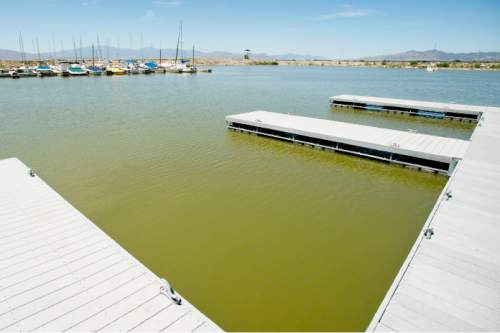This is an archived article that was published on sltrib.com in 2015, and information in the article may be outdated. It is provided only for personal research purposes and may not be reprinted.
Almost a year after toxic algae at Utah Lake killed two dogs, state water-quality managers have developed the first guidelines for dealing with the potentially deadly blooms.
The Utah Division of Water Quality and the Utah Department of Health have released benchmarks meant to protect the public — and their pets — from the rising prevalence of poisonous blue-green vegetation in state waters. The guidelines, which are nonbinding recommendations for local health departments, include suggested "warning" and "lake closed" signs, as well as an algorithm to help local officials decide when it is appropriate to post such signs.
In the absence of a regular monitoring program — which the state has little funding for — the guidelines also recommend when and how local health departments should start taking samples to test for the presence of toxic algae.
"To actually do this right and monitor each of our reservoirs on a weekly basis would be a huge endeavor," said Erica Gaddis, assistant director of watersheds monitoring at the Utah Division of Water Quality.
So in the meantime, water regulators say, voluntary guidelines are the best they can do.
At a meeting of the state's Water Quality and Health Advisory Panel this week, scientists warned that 44 percent of Utah's waterways — including several drinking-water sources — are at risk of developing poisonous algal blooms.
While not all blooms are harmful, some types of algae and a group of bacteria known as cyanobacteria, or blue-green algae, are capable of producing chemicals which can be harmful or even fatal when ingested by animals — and people.
The most common of the harmful algae, said Craig Dietrich, an environmental epidemiologist for the state department of health, produce toxins that damage the liver.
Less common algae produce neurotoxins, including a toxin known as Anatoxin-a. Before it was fully understood, Dietrich said, scientists called Anatoxin-a "very sudden death factor," because the toxin, which is capable of causing respiratory failure in as little as 20 minutes, breaks down extremely quickly in the environment and is difficult to detect.
Most people understand that it's unwise to drink stagnant water, Dietrich said, so the toxins don't pose a huge risk to humans. But livestock and pets — especially dogs — are another matter.
"Dogs love to get into things that are strange and smelly," he said. "And they consistently will drink surface waters that you let them get into."
Two dogs died after being exposed to Utah Lake water on Oct. 4 and 5 of last year. At the time, toxins in some samples taken from the lake's Lindon Marina were 70 times World Health Organization advisory levels.
The state veterinarian who performed necropsies on the animals was certain at least one of the dogs died after ingesting Anatoxin-a, Dietrich said. However, samples from Utah Lake contained only trace, almost undetectable, levels of the neurotoxin. Liver toxins, on the other hand, were widely present on the lake's shoreline during the episode.
Recurring algal blooms at Matt Warner Reservoir in 2004 and 2010 were believed to be the cause of 18 cattle deaths in the Vernal area.
Utah is not the first state struggling to manage algal blooms, Gaddis said. Several states have issued advisories or recommendations this year.
The U.S. Environmental Protection Agency also released guidelines on algal toxins in drinking water earlier this year after a severe bloom in Toledo, Ohio forced the city to cut water service to 500,000 residents in 2014. The EPA is expected to release additional non-binding guidelines on algal blooms in recreational waters later this fall.
Nationwide, the frequency of algal bloom events has increased 30-fold since the 1960s, according to Ben Holcomb, an environmental scientist with the Division of Water Quality.
The Utah waterways most at risk of developing blooms have high levels of nutrients that promote algal growth, including phosphorus and nitrogen, Gaddis said. Most bodies of water that develop algal blooms also are shallow, stagnant and often warm during the late summer months. When human activity elevates the nutrient levels in the water, the frequency of algal blooms increases, she said.
Reducing nutrient levels can successfully reverse the risk of algal blooms. At East Canyon Reservoir, a popular recreation area and state park, changes at an upstream waste treatment plant in 2003-2004 prevented past algal blooms from recurring, Gaddis said.
But in the case of severely polluted bodies of water such as Utah Lake, Holcomb said that kind of reversal can take decades to take full effect.
According to Holcomb, 11 Utah drinking water sources — including Pineview Reservoir and Deer Creek Reservoir — have produced algal blooms.
And Big and Little Cottonwood watersheds both have had trouble with algae, Dietrich said.
Gaddis said she could not provide the entire list of algae-affected watersheds due to homeland security concerns.
The list of bloom-plagued bodies of water also includes 18 that are widely used for recreation, but do not provide drinking water.
While Division of Water Quality scientists visit each of Utah's lakes and reservoirs twice during the summer to test the water quality, Gaddis said the state currently has no budget to monitor for algal blooms — an endeavor she said would be extremely costly.
"I think eventually we will find a way to fund the program," she said. "But this is the first year we've even had any kind of organized program."
That could change if the EPA decides to provide additional funding for monitoring, Gaddis said. But in the meantime, the state relies on residents to report algal blooms.
The Division of Water Quality is developing a website with more information about how to identify and report potentially harmful algal blooms. Until the website goes live, Gaddis suggested residents contact their local health department to report algal blooms in their area.





